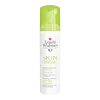What's inside
What's inside
 Key Ingredients
Key Ingredients

 Benefits
Benefits

 Concerns
Concerns

 Ingredients Side-by-side
Ingredients Side-by-side

Water
Skin ConditioningGlycolic Acid
BufferingGlycerin
HumectantCocamidopropyl Betaine
CleansingSodium Hydroxide
BufferingPolysorbate 80
EmulsifyingPropylene Glycol
HumectantSodium Laureth Sulfate
CleansingMethylpropanediol
SolventGlycyrrhetinic Acid
Skin ConditioningDipotassium Glycyrrhizate
HumectantCocamidopropyl Betainamide Mea Chloride
CleansingPotassium Sorbate
PreservativeCocamidopropyl Dimethylamine
EmulsifyingCI 19140
Cosmetic ColorantCI 15985
Cosmetic ColorantWater, Glycolic Acid, Glycerin, Cocamidopropyl Betaine, Sodium Hydroxide, Polysorbate 80, Propylene Glycol, Sodium Laureth Sulfate, Methylpropanediol, Glycyrrhetinic Acid, Dipotassium Glycyrrhizate, Cocamidopropyl Betainamide Mea Chloride, Potassium Sorbate, Cocamidopropyl Dimethylamine, CI 19140, CI 15985
Water
Skin ConditioningSodium Laureth Sulfate
CleansingPropylene Glycol
HumectantDisodium Laureth Sulfosuccinate
CleansingDecyl Glucoside
CleansingPolypropylene Terephthalate
Emulsion StabilisingSodium Cocoamphoacetate
CleansingPanthenol
Skin ConditioningSalicylic Acid
MaskingPolysorbate 20
EmulsifyingSodium Benzoate
MaskingEthylhexylglycerin
Skin ConditioningLauryl Pyrrolidone
CleansingAllantoin
Skin ConditioningSodium Chloride
MaskingBenzoic Acid
MaskingPantolactone
HumectantWater, Sodium Laureth Sulfate, Propylene Glycol, Disodium Laureth Sulfosuccinate, Decyl Glucoside, Polypropylene Terephthalate, Sodium Cocoamphoacetate, Panthenol, Salicylic Acid, Polysorbate 20, Sodium Benzoate, Ethylhexylglycerin, Lauryl Pyrrolidone, Allantoin, Sodium Chloride, Benzoic Acid, Pantolactone
Ingredients Explained
These ingredients are found in both products.
Ingredients higher up in an ingredient list are typically present in a larger amount.
Propylene Glycol is an odorless, colorless liquid. As a humectant, it helps skin retain moisture. It also aids in delivering active ingredients.
Another role of this ingredient is preventing a product from melting or freezing. Propylene glycol also adds antimicrobrial properties to a product, elongating product lifespan.
This ingredient is considered an organic alcohol and commonly added into both cosmetics and foods.
Those with sensitive skin or conditions may develop a rash when using this ingredient.
Learn more about Propylene GlycolSodium Laureth Sulfate (SLES) is a foaming, cleansing, and emulsifying ingredient. It is created from palm kernel oil or coconut oil. SLES is not the same as sodium lauryl sulfate. It is much milder and less likely to irritate.
SLES helps create foam in personal products. It also prevents ingredients from separating, helping to elongate the shelf life.
Sodium Laureth Sulfate is a type of sulfate. It can be drying. We recommend speaking with a professional about using this ingredient if you have concerns.
Learn more about Sodium Laureth SulfateWater. It's the most common cosmetic ingredient of all. You'll usually see it at the top of ingredient lists, meaning that it makes up the largest part of the product.
So why is it so popular? Water most often acts as a solvent - this means that it helps dissolve other ingredients into the formulation.
You'll also recognize water as that liquid we all need to stay alive. If you see this, drink a glass of water. Stay hydrated!
Learn more about Water